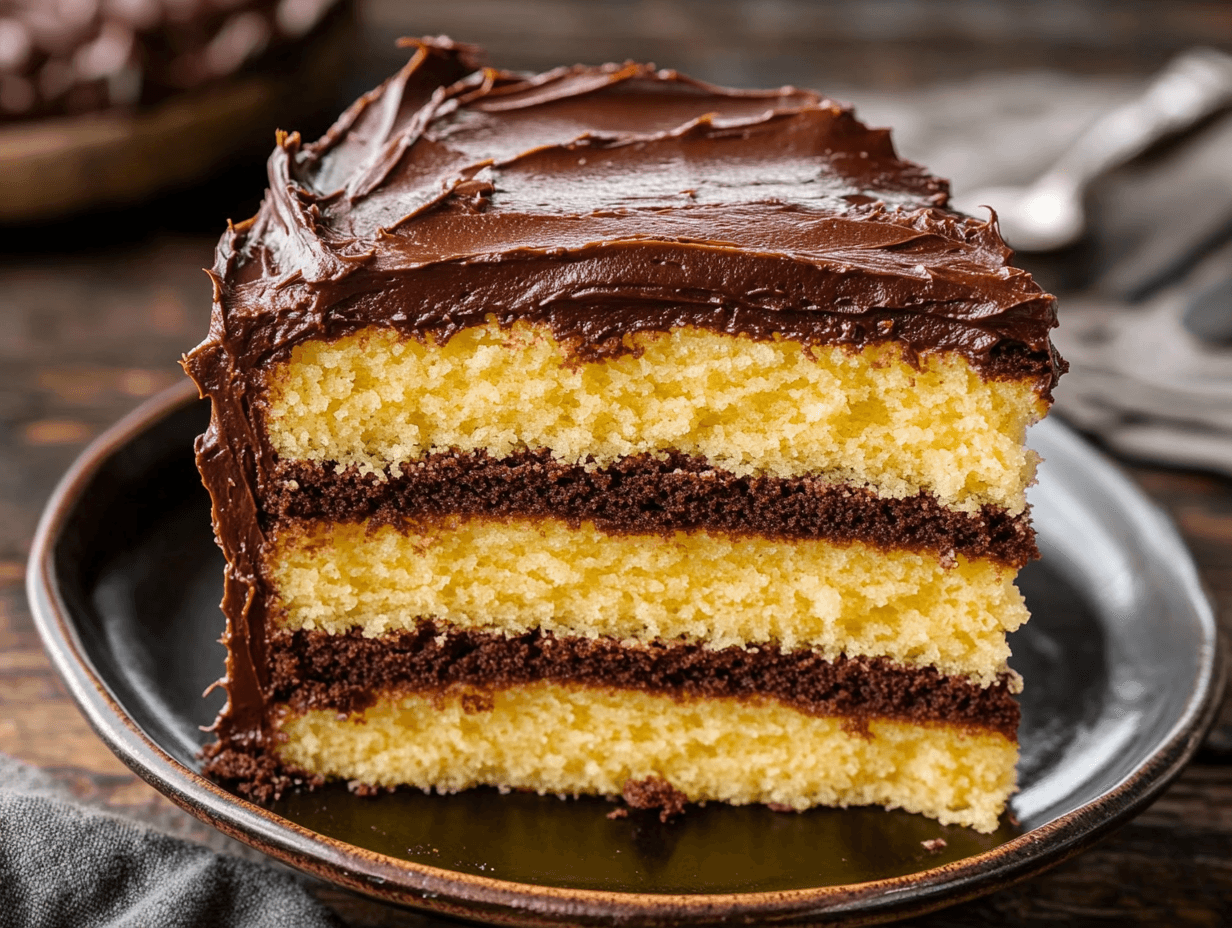There’s something magical about a chocolate cake with vanilla frosting. This classic dessert is perfect for birthdays, holidays, or any special occasion where you want to impress guests with a delicious, homemade cake. The rich, moist chocolate cake paired with the sweet and creamy vanilla frosting creates a balance of flavors that everyone loves. Plus, this recipe is simple enough for beginners but satisfying for even the most seasoned bakers.
In this article, we will walk you through the process of making this delightful treat from scratch, ensuring that your cake is moist, flavorful, and visually stunning. Whether you are baking for a celebration or simply satisfying your sweet tooth, follow these steps to create the perfect chocolate cake with vanilla frosting. If you’re wondering how to keep your cake moist and fluffy, you can check out these helpful tips for achieving moist cakes.
Ingredients Breakdown
Before you start, it’s essential to gather all your ingredients. Using quality ingredients, like real vanilla extract, can make a significant difference in the taste and texture of your cake. Here’s a breakdown of what you’ll need:
For the Chocolate Cake:
- 1 ¼ cups unsweetened cocoa powder
- 2 ½ cups all-purpose flour
- 2 ½ cups sugar
- 2 ½ teaspoons baking soda
- 1 ¼ teaspoons baking powder
- 1 ¼ teaspoons salt
- 2 large eggs plus 1 large egg yolk
- 1 ¼ cups warm water
- 1 ¼ cups buttermilk
- ½ cup plus 2 tablespoons vegetable oil
- 1 ½ teaspoons vanilla extract
For the Vanilla Frosting:
- 1 cup unsalted butter, softened
- 4-5 cups powdered sugar
- 2 teaspoons vanilla extract
- 2-4 tablespoons milk or heavy cream
Remember, using high-quality vanilla in your frosting adds a depth of flavor you won’t get from imitation products. To learn more about choosing the right vanilla, you can explore different types of buttercream frosting.
Step-by-Step Guide for Making the Chocolate Cake
1. Prepare the Cake Pans and Preheat the Oven
Preheat your oven to 350°F (175°C). Grease two 9-inch round cake pans and line the bottoms with parchment paper. This will prevent the cake from sticking and ensure easy removal.
2. Mix the Dry Ingredients
In a large bowl, sift together the cocoa powder, flour, baking soda, baking powder, and salt. Sifting helps remove lumps and ensures even mixing. This step is essential for creating a smooth, lump-free cake batter.
3. Add the Wet Ingredients
In a separate bowl, whisk together the eggs, buttermilk, oil, warm water, and vanilla extract. Slowly add the wet ingredients into the dry ingredients, mixing gently to combine. Be careful not to overmix the batter, as this can result in a dense cake.
4. Bake the Cake
Divide the batter evenly between the two prepared pans. Bake for 30-35 minutes, or until a toothpick inserted into the center comes out clean. Allow the cakes to cool in the pans for about 10 minutes, then transfer them to wire racks to cool completely.
Making the Vanilla Frosting
1. Cream the Butter
In a large mixing bowl, beat the softened butter until it’s smooth and creamy. Using room temperature butter is key to achieving a smooth texture for your frosting.
2. Add Powdered Sugar
Gradually add the powdered sugar, 1 cup at a time, while continuing to mix. Start on low speed to avoid a sugar cloud in your kitchen! The powdered sugar will thicken the frosting and give it structure.
3. Add Vanilla and Cream
Once all the powdered sugar is incorporated, add the vanilla extract and 2 tablespoons of cream or milk. Mix on high until the frosting is light and fluffy. If the frosting is too thick, add more cream (1 tablespoon at a time) until you reach your desired consistency.
4. Adjust to Your Preference
If you’d like a slightly tangier frosting, consider adding a dash of lemon juice or almond extract for an exciting twist on the traditional vanilla flavor.
Assembling and Frosting the Cake
1. Level the Cake Layers
After the cakes have cooled, use a serrated knife to level the tops if necessary. This step ensures even, flat layers, making it easier to frost.
2. Apply a Crumb Coat
Start by spreading a thin layer of frosting over the cake, called a crumb coat. This traps any loose crumbs and provides a smooth surface for the final layer of frosting. Refrigerate the cake for 20-30 minutes to allow the crumb coat to set.
3. Final Layer of Frosting
Once the crumb coat has set, frost the cake with a thicker layer of vanilla frosting, using an offset spatula for a smooth finish. For tips on perfecting your frosting technique, check out how to properly level cake layers.
4. Decorating Options
Now comes the fun part—decorating! You can keep it simple with sprinkles or add more elegance with chocolate shavings or piped frosting details. For a more festive touch, try topping the cake with fresh berries or edible flowers.
Storing and Serving Tips
Storing the Cake
You can store the cake at room temperature for up to 2 days. If you’re not planning to serve it immediately, cover it tightly and refrigerate. The cake will stay fresh for up to 5 days in the fridge.
Freezing
If you want to prepare the cake in advance, you can freeze the unfrosted cake layers. Wrap them tightly in plastic wrap and store in the freezer for up to 3 months. When you’re ready to assemble the cake, let the layers thaw completely before frosting.
Serving Suggestions
This chocolate cake with vanilla frosting pairs perfectly with a glass of cold milk, hot coffee, or even a scoop of vanilla ice cream. It’s an excellent dessert for both casual family dinners and more formal celebrations.
Troubleshooting Common Issues
Even with the best recipes, sometimes things don’t go as planned in the kitchen. Fortunately, these common cake issues are often easy to fix with a few adjustments. Below are some typical problems you might encounter while making chocolate cake with vanilla frosting, along with simple solutions to get your cake back on track.
Cake is Too Dry
One of the most common problems is a dry cake, which can be disappointing after all the effort you’ve put in. This issue is typically caused by overbaking or using too much flour.
- Solution: First, ensure that your oven is calibrated correctly. Often, an oven may run hotter than the temperature displayed. Consider using an oven thermometer to get an accurate reading. Also, keep an eye on your cake during baking and check it a few minutes before the recommended baking time is over. A toothpick should come out with a few moist crumbs, not completely clean, which indicates the cake is perfectly done. For more tips on achieving a perfectly moist cake, you can explore how to make moist cakes.
Frosting is Too Runny
If your vanilla frosting turns out too runny, this can make it difficult to achieve a smooth, professional finish. Several factors can cause runny frosting, including adding too much liquid or not enough powdered sugar.
- Solution: Start by adding more powdered sugar, one tablespoon at a time, until the frosting reaches your desired thickness. Additionally, you can place the frosting in the fridge for about 10-15 minutes to help it firm up. If you’re looking for more details on how to perfect buttercream frosting, check out this guide on types of buttercreamfrosting.
Cake Sinks in the Middle
Another frustrating issue is when a cake sinks in the middle. This is often caused by either opening the oven door too early or overmixing the batter, both of which can affect the cake’s rise.
- Solution: Avoid opening the oven door during the first half of the baking time, as this sudden change in temperature can cause the cake to collapse. Also, when mixing your batter, be careful not to overdo it—mix just until the ingredients are combined. Overmixing can introduce too much air, which then deflates during baking. Ensure the cake is fully baked before removing it from the oven, as an underbaked cake is more likely to sink. If you’re unsure whether your cake is done, use the toothpick test.
Conclusion
A chocolate cake with vanilla frosting is a classic dessert that consistently impresses. By following this step-by-step guide, you’ll be able to create a cake that is not only moist and delicious but also visually appealing. Whether you’re baking for a birthday, a special event, or simply to treat yourself, mastering this combination will elevate your baking skills. With a few simple techniques, such as leveling the layers and applying a crumb coat, your cake will have a professional finish that everyone will love.
So, what are you waiting for? Gather your ingredients, preheat the oven, and get ready to bake a perfect chocolate cake with vanilla frosting. With some creativity in decorating, you’ll have a dessert that tastes amazing and looks stunning. Whether you’re new to baking or a seasoned pro, this recipe is a must-try for any cake lover.

